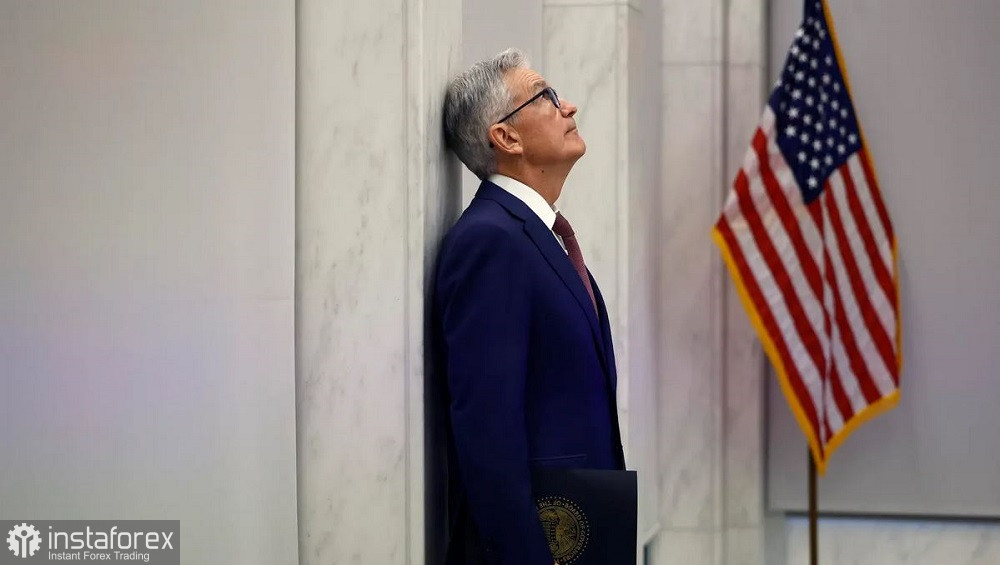Federal Reserve Chairman Jerome Powell boosted the dollar bulls yesterday by stating his readiness to raise the interest rate again "if necessary." In essence, he voiced a standard phrase, which he has uttered more than once—including at the recent year-end press conference. However, in the current fundamental conditions, his words provided support for the American currency.
Traders awaited his reaction to the disappointing Nonfarm Payrolls report, reflecting a slowdown in the U.S. labor market in October. But Powell essentially ignored this report, focusing his attention on the strong growth of the American economy. The tone of his rhetoric noticeably hardened (even compared to his recent appearance at the press conference following the November meeting), and this fact allowed sellers of EUR/USD to test the support level of 1.0650, corresponding to the lower line of the Bollinger Bands indicator on the four-hour chart.
The key thesis voiced by Powell is encapsulated in a simple phrase: the Federal Reserve is not sure that the interest rate is high enough to effectively contain inflation. According to him, inflation can change direction, so further progress towards achieving the two percent target level is "not guaranteed." In this context, he expressed concern about the significant increase in the U.S. GDP in the third quarter of this year (4.9%). According to him, this fact could well undermine progress in the fight against inflation. Although the Federal Reserve expects a slowdown in economic growth in the coming quarters, "this still remains to be confirmed."

Regarding the October Nonfarm Payrolls, the Fed Chair noted that the labor market remains tense, although improvements in workforce supply and gradual weakening of demand continue to balance it.
It is worth emphasizing that Jerome Powell did not announce additional tightening of monetary policy, contrary to "loud" headlines in some media. In essence, he simply reiterated the phrase he stated after the November meeting—that the central bank makes decisions from meeting to meeting based on the aggregate of incoming data. Considering that two more inflation reports (the first of which is next week) and another Nonfarm Payrolls report will be published before the December meeting, it is not appropriate to talk about any clear perspectives of policy tightening at the moment.
Judging by the reaction of the EUR/USD pair, many market participants have drawn similar conclusions. The pair set a weekly price low (1.0650), but the "downward rally" concluded smoothly.
Another notable fact is that Powell's hawkish remarks failed to strengthen the market's hawkish expectations—neither in the context of the December meeting nor in the context of January. The probability of an increase in the Fed's rate next month is only 9% (according to the CME FedWatch Tool), and for January, it is 19%. Most importantly, traders still expect a softening of the Fed's policy in the first half of 2024. The probability of a rate cut next spring (at the May meeting) is more than 30%, and at the first summer meeting, it is over 40%.
Thus, no revolutionary changes occurred in the market after Powell's speech yesterday. Indeed, he slightly hardened his rhetoric, but at the same time, he did not say anything fundamentally new: the decision in December (or January) will depend on the dynamics of October (or November) inflation.
Dollar bulls seized upon Powell's statement that the Federal Reserve will make decisions cautiously but, if necessary, "will promptly raise the interest rate again" (he added that the regulator is not currently guided by the rise in long-term Treasury yields). These remarks sound truly hawkish, but if the inflation report next week comes out in the "red zone," Powell's words will lose their relevance, and the dollar will again be under significant pressure. That is likely why the EUR/USD pair demonstrated such a modest reaction—the fate of policy decisions is de facto "in the hands" of inflation, which can adjust (soften) the hawks' position at the Fed.
In anticipation of the key inflation release (the report on CPI growth for October will be announced on November 14, next Tuesday), market participants are unlikely to risk making bets on or against the dollar. Recall that in September, the overall Consumer Price Index remained at the August level, and the Core CPI sharply declined to 4.1% (the lowest value since September 2021). If both indicators demonstrate a downward trend in October, it will be quite challenging for the Fed's hawks to argue the need for another rate hike—at least in the context of the December meeting.
Given the high degree of uncertainty, it can be assumed that the EUR/USD pair will drift in the range of 1.0650–1.0730 in the near future (before the CPI release), between the middle and upper lines of the Bollinger Bands indicator on the four-hour chart.





















